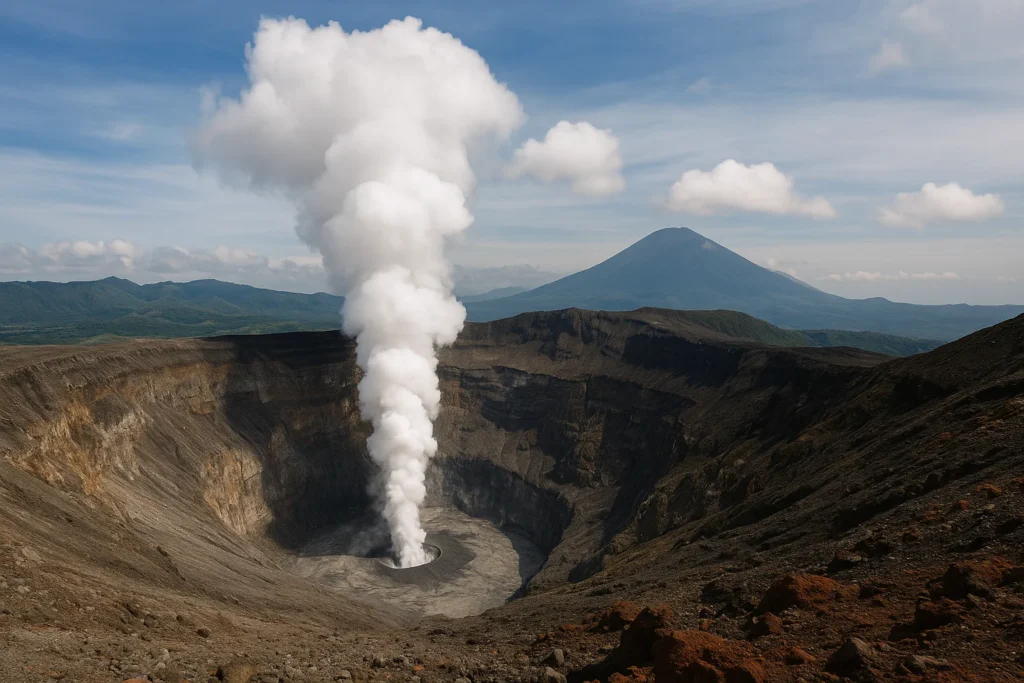The Uneasy Ground of Naples
Pozzuoli, Italy—a picturesque coastal town where Roman ruins meet modern cafés—has become the unlikely epicenter of global volcanological attention. Here, the ground doesn’t remain still. Since 2005, the city has experienced over 3 meters of vertical displacement, with the pace accelerating alarmingly in recent months. The historic Rione Terra district now stands nearly 4 meters higher than it did in the 1970s, its medieval buildings tilted at surreal angles, their stone facades fractured by relentless geological forces.
Beneath the feet of Pozzuoli’s 80,000 residents lies Campi Flegrei (the “Burning Fields”), a 13-kilometer-wide volcanic caldera that last erupted in 1538. But scientists now believe this system may be preparing for something far more catastrophic—a repeat of its world-altering eruption 39,000 years ago that may have contributed to the extinction of Neanderthals.
Yellowstone’s Restless Pulse
Meanwhile, in North America’s wilderness crown jewel, Yellowstone National Park’s famous geysers have begun behaving erratically. Steamboat Geyser, the world’s tallest active geyser, has erupted more frequently in the past five years than in the previous fifty combined. The park’s seismic stations record an average of 1,500–2,000 earthquakes annually, but recent swarms have seen that number spike dramatically.
Beneath the park’s stunning landscapes lurks one of Earth’s most massive magma chambers—a seething reservoir of molten rock large enough to fill the Grand Canyon nearly fourteen times over. When this system last erupted 640,000 years ago, it blanketed half of North America in volcanic ash and likely altered global climate patterns for decades.
Understanding Supervolcanoes: Nature’s Ultimate Reset Buttons
Defining the Supervolcanic Scale
Supervolcanoes represent the upper extreme of volcanic power, defined by their potential to eject more than 1,000 cubic kilometers of material in a single eruption—enough to:
- Cover an entire continent in ash
- Significantly alter global climate for years
- Potentially trigger mass extinction events
The Volcanic Explosivity Index (VEI) classifies these as magnitude 8 eruptions—events orders of magnitude more powerful than the 1980 Mount St. Helens eruption (VEI 5) or even the legendary 1883 Krakatoa eruption (VEI 6).
The Global Network of Supervolcanic Threats
While Yellowstone and Campi Flegrei currently dominate scientific attention, they are but two nodes in a global network of potential supervolcanic threats:
Taupō Volcanic Zone (New Zealand)
- Site of Earth’s most recent supereruption (~232 CE)
- Currently shows elevated seismic activity
- Capable of disrupting global air travel
Toba Caldera (Indonesia)
- Site of the largest eruption in the last 25 million years (~74,000 years ago)
- Genetic evidence suggests it nearly wiped out early humans
- Still considered active with significant magma reserves
Long Valley Caldera (California)
- Erupted violently 760,000 years ago
- Shows persistent ground uplift
- Threatens major West Coast population centers
Uturuncu (Bolivia)
- Dormant for 250,000 years
- Now showing signs of magma recharge
- Potential to disrupt Southern Hemisphere climate
The Cutting Edge of Supervolcano Monitoring
Next-Generation Surveillance Technologies
Modern volcanology has developed an arsenal of sophisticated monitoring tools:
Space-Based Observation Systems
- Sentinel-1 Radar Satellites: Detect millimeter-scale ground deformation
- Landsat Thermal Imaging: Track surface temperature changes
- Gravity Recovery Satellites: Measure magma chamber density changes
Ground-Based Monitoring Arrays
- Fiber-Optic Seismic Networks: Turn existing cables into thousands of seismic sensors
- Quantum Gravimeters: Detect subtle density changes in underground magma
- Autonomous Gas-Sampling Drones: Collect dangerous plume samples
Advanced Computational Modeling
- Machine learning algorithms analyze decades of seismic data
- Supercomputer simulations predict eruption scenarios
- Real-time data assimilation improves forecast accuracy
The Human Network: Global Volcano Monitoring
Yellowstone Volcano Observatory (YVO)
- 24/7 monitoring by USGS scientists
- Coordinates with National Park Service
- Maintains public alert systems
Campi Flegrei Monitoring Center
- Operated by Italy’s National Institute of Geophysics
- Works with civil protection authorities
- Conducts public preparedness drills
World Organization of Volcano Observatories
- Facilitates international cooperation
- Standardizes monitoring protocols
- Provides technical assistance globally
Historical Perspectives: Lessons from Past Cataclysms
Campi Flegrei’s Destructive Legacy
The Phlegraean Fields have shaped Mediterranean history through several catastrophic events:
Campanian Ignimbrite Eruption (~39,000 years ago)
- VEI 7 event that ejected 500 km³ of material
- May have caused volcanic winter lasting years
- Potentially contributed to Neanderthal extinction
Neapolitan Yellow Tuff (~15,000 years ago)
- Formed much of modern Naples’ foundation
- Created the distinctive building stone used throughout the city
- Estimated magnitude similar to 1883 Krakatoa
Monte Nuovo (1538)
- Last eruption at Campi Flegrei
- Formed a new 139-meter mountain in eight days
- Forced abandonment of several villages
Yellowstone’s Explosive Timeline
The Yellowstone hotspot has produced three continent-altering eruptions:
Huckleberry Ridge (2.1 million years ago)
- VEI 8 supereruption ejecting 2,500 km³ of material
- Ashfall reached as far as modern-day Missouri
- Climate impacts likely lasted decades
Mesa Falls (1.3 million years ago)
- Smaller but still catastrophic eruption
- Created the Island Park Caldera
- Significant regional ecological disruption
Lava Creek (640,000 years ago)
- Formed current Yellowstone Caldera
- Ash deposits found across North America
- May have affected early human migration patterns
Current Concerns: Interpreting the Warning Signs
Campi Flegrei’s Accelerating Activity
Recent developments have prompted Italy to elevate its alert level:
Ground Deformation (Bradyseism)
- 3.5 meters of uplift since 1950
- Current rate: ~10 cm per year
- Causes structural damage to buildings
Seismic Activity
- Increasing frequency of magnitude 3+ earthquakes
- Shallow quakes (1-3 km depth) suggesting magma movement
- Harmonic tremor signals indicating fluid motion
Geochemical Changes
- Rising CO₂ emissions from soil
- Changing ratios of noble gases
- Increased fumarole temperatures
Yellowstone’s Changing Behavior
While not at immediate risk, Yellowstone shows noteworthy changes:
Hydrothermal System Dynamics
- Steamboat Geyser’s record-breaking activity
- Shifting eruption patterns at Old Faithful
- New thermal features appearing
Seismic Activity
- Earthquake swarms with hundreds of events
- Increasing deep seismicity (10-20 km depth)
- Changing focal mechanisms
Ground Deformation
- Norris Geyser Basin uplift episodes
- Seasonal patterns becoming less predictable
- GPS vectors showing complex movement
Potential Global Impacts: When the Unthinkable Happens
Immediate Effects (First 72 Hours)
Local Devastation (0-100 km from eruption)
- Complete destruction from pyroclastic flows (300-700°C, 100-300 km/h)
- Total darkness from falling ash
- Toxic gas concentrations lethal within minutes
Regional Impacts (100-1,000 km)
- Building collapses from ash accumulation
- Water supply contamination
- Transportation network paralysis
Medium-Term Consequences (First Year)
Climate Effects
- Global temperature drops of 3-5°C
- Stratospheric aerosol veil reducing sunlight
- Disrupted precipitation patterns
Agricultural Collapse
- Growing seasons shortened dramatically
- Photosynthesis significantly reduced
- Livestock poisoned by fluorosis
Infrastructure Failure
- Electrical grid damage from conductive ash
- Water treatment plant failures
- Communication network disruptions
Long-Term Global Impacts (1-10 years)
Economic Shockwaves
- Global GDP contraction of 5-15%
- Insurance industry collapse
- Mass migration from affected regions
Societal Stress
- Food rationing and resource conflicts
- Breakdown of just-in-time supply chains
- Potential for widespread civil unrest
Mitigation Strategies: Preparing for the Inevitable
Scientific Preparedness
Enhanced Monitoring Networks
- Expanding sensor density in critical areas
- Developing autonomous monitoring stations
- Implementing real-time data assimilation
Improved Modeling Capabilities
- Higher-resolution magma chamber imaging
- Better understanding of eruption triggers
- More accurate ash dispersion forecasting
Engineering Solutions
Ash-Resistant Infrastructure
- Reinforced building codes for ash load
- Protected water supply systems
- Hardened electrical infrastructure
Atmospheric Intervention Concepts
- Stratospheric aerosol monitoring systems
- Potential climate mitigation technologies
- Emergency atmospheric cleansing proposals
Societal Preparedness
Global Food Security
- Strategic grain reserves
- Alternative food production methods
- Emergency distribution networks
International Response Frameworks
- Supervolcano response treaties
- Coordinated evacuation plans
- Resource sharing agreements
The Road Ahead: Living with Geological Uncertainty
Ongoing Research Initiatives
Campi Flegrei Deep Drilling Project
- Planned 3.5 km borehole to monitor magma
- Installation of permanent sensors
- Improved eruption forecasting
Yellowstone Monitoring 2030 Initiative
- Doubling seismic station density
- New gas monitoring networks
- Advanced deformation measurement
International Cooperation Efforts
Global Volcano Early Warning System
- UN-coordinated monitoring network
- Standardized alert levels
- Shared best practices
Supervolcano Response Framework
- Pre-negotiated resource sharing
- Evacuation coordination protocols
- Scientific task force mobilization
Public Education and Awareness
Living with Volcanoes Programs
- Community preparedness training
- School curriculum development
- Media partnerships for accurate reporting
Citizen Science Initiatives
- Crowdsourced monitoring apps
- Volunteer observation networks
- Public participation in drills
Conclusion: An Awakened Responsibility
The increased activity at Campi Flegrei and Yellowstone serves as a powerful reminder of humanity’s precarious position on Earth’s dynamic surface. While the probability of a catastrophic supereruption in our lifetime remains relatively low, the potential consequences demand our focused attention and preparation.
Modern science now provides us with tools our ancestors never had—the ability to monitor these sleeping giants in real-time, to understand their rhythms, and potentially to forecast their awakening with increasing accuracy. Yet with this knowledge comes profound responsibility: to prepare our societies, to harden our infrastructure, and to develop response systems that could save millions of lives when—not if—the next supereruption occurs.
As the ground continues to shift beneath Pozzuoli’s streets and Yellowstone’s geyser basins murmur their ancient songs, we find ourselves at a unique moment in human history—possessing both the scientific understanding to recognize these threats and the technological capability to prepare for them. The question before us is whether we will rise to meet this challenge with the urgency and cooperation it demands.



